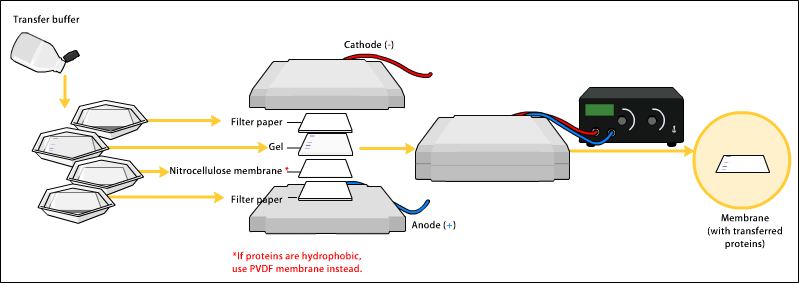western blotting is a widely used analytical technique used to detect specific proteins in the given sample of tissue homogenate or extract.

It uses gel electrophoresis to separate denatured proteins by the length of the polypeptide. The proteins are then transferred to a membrane (typically nitrocellulose or PVDF), where they are probed (detected) using antibodies specific to the target protein.

It uses gel electrophoresis to separate denatured proteins by the length of the polypeptide. The proteins are then transferred to a membrane (typically nitrocellulose or PVDF), where they are probed (detected) using antibodies specific to the target protein.
It Gives You Information on the:
- Size of your Protein
- Expression Amount of your ProteinSodium dodecyl sulfate polyacrylamide gel electrophoresis
SDS-PAGE
Used to separate protein molecules according to their sizes.
Transfer Proteins to a Membrane (blotting)
-Following electrophoresis, the protein must be transferred from the electrophoresis gel to a membrane. There are a variety of methods that have been used for this process, including diffusion transfer, capillary transfer, heat-accelerated convectional transfer, vacuum blotting transfer and electroelution.
-The transfer method that is most commonly used for proteins is electroelution or electrophoretic transfer because of its speed and transfer efficiency. Electrophoretic transfer of proteins involves placing a protein-containing polyacrylamide gel in direct contact with a piece of nitrocellulose or PVDF membrane and "sandwiching" this between two electrodes submerged in a conducting solution.
-When an electric field is applied, the proteins move out of the polyacrylamide gel and onto the surface of the membrane, where the proteins become tightly attached.
There are two types of apparatus for electrophoretic transfer :
A-wet transfer:
the gel/blotting paper/filter paper sandwich is placed into a cassette along with protective fiber pads. The cassette is then immersed in a buffer tank and subjected to an electrical field. The electric field used for the transfer is oriented perpendicular to the surface of the gel causing proteins to move out of the gel and onto the blotting membrane, which sits between the gel surface and the positive electrode.
B-semi-dry transfer:
the gel/blotting paper/filter paper sandwich is assembled on large electrode
plates which generate the electric field, and buffer is confined to the stack
of wet filter papers.
In semi dry blotting the gel and the membrane are horizontally between two stacks of buffer wetted filter papers in direct contact with two closely spaced solid plate electrodes .the term semi dry refers to the limited amount of buffer that is confined to the stacks of filter papers.

-After transfer and before proceeding with the Western blot, total protein on the membrane is often stained with a dye, such as Ponceau S or amido black 10B, to check the transfer efficiency, the gel may also be stained to confirm that protein has been moved out of the gel.
-Following electrophoresis, the protein must be transferred from the electrophoresis gel to a membrane. There are a variety of methods that have been used for this process, including diffusion transfer, capillary transfer, heat-accelerated convectional transfer, vacuum blotting transfer and electroelution.
-The transfer method that is most commonly used for proteins is electroelution or electrophoretic transfer because of its speed and transfer efficiency. Electrophoretic transfer of proteins involves placing a protein-containing polyacrylamide gel in direct contact with a piece of nitrocellulose or PVDF membrane and "sandwiching" this between two electrodes submerged in a conducting solution.
-When an electric field is applied, the proteins move out of the polyacrylamide gel and onto the surface of the membrane, where the proteins become tightly attached.
There are two types of apparatus for electrophoretic transfer :
A-wet transfer:
the gel/blotting paper/filter paper sandwich is placed into a cassette along with protective fiber pads. The cassette is then immersed in a buffer tank and subjected to an electrical field. The electric field used for the transfer is oriented perpendicular to the surface of the gel causing proteins to move out of the gel and onto the blotting membrane, which sits between the gel surface and the positive electrode.
B-semi-dry transfer:
the gel/blotting paper/filter paper sandwich is assembled on large electrode
plates which generate the electric field, and buffer is confined to the stack
of wet filter papers.
In semi dry blotting the gel and the membrane are horizontally between two stacks of buffer wetted filter papers in direct contact with two closely spaced solid plate electrodes .the term semi dry refers to the limited amount of buffer that is confined to the stacks of filter papers.

-After transfer and before proceeding with the Western blot, total protein on the membrane is often stained with a dye, such as Ponceau S or amido black 10B, to check the transfer efficiency, the gel may also be stained to confirm that protein has been moved out of the gel.






0 التعليقات:
Post a Comment